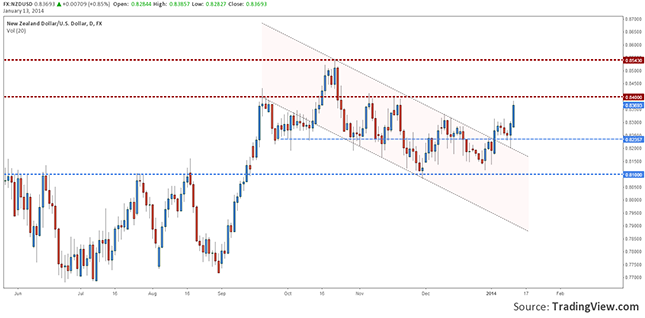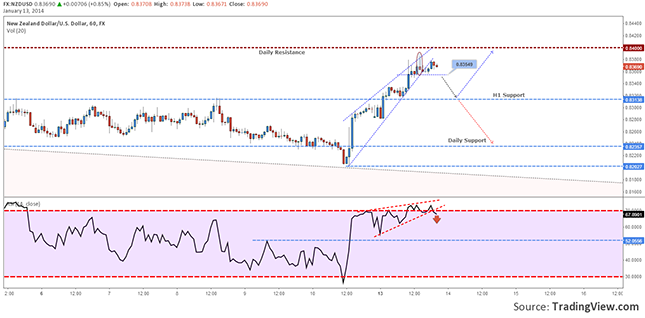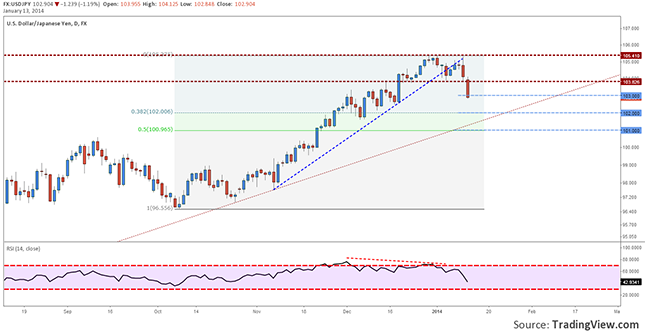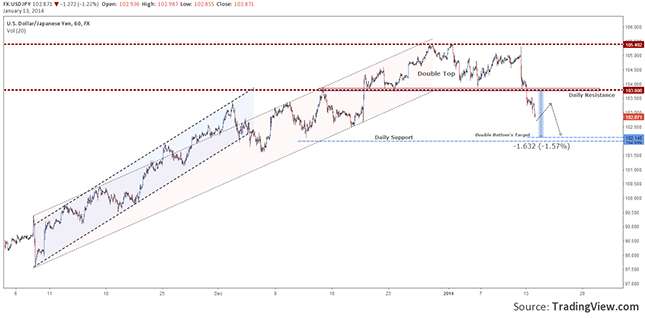Source: Kevin Michael Grace of The Gold Report (1/13/14)
http://www.theaureport.com/pub/na/chen-lin-says-investors-should-bank-on-balance-sheets-while-waiting-for-the-next-wave-in-gold-and-gold-miners
For over a decade, mining companies have relied on a rising gold price to reward their decisions, regardless of whether they were good decisions. Those days are over, and Chen Lin, author of the What is Chen Buying? What is Chen Selling? newsletter, says that investors must embrace companies that can grow their balance sheets even with gold as low as $1,000/ounce. Companies that can generate cash flow and acquire assets at fire sale prices today will likely be the winners in the next wave. In this interview with The Gold Report, Lin identifies a handful of producers that meet this threshold and one explorer well positioned to join their ranks.
The Gold Report: You told The Gold Report in June that you were still bullish on gold “in the long run.” Are you still bullish? And how soon is the long run?
Chen Lin: Gold may continue to correct in 2014 and maybe even longer. There is a chance it will hit $1,000/ounce ($1,000/oz). However, inflation will pick up as the result of all the money printing by the central banks. That’s when gold’s run will really begin.
TGR: You’ve said that the price of gold is being controlled by the “paper market on Wall Street.” Could you elaborate on that?
CL: You can use very little money down to buy gold using the future markets. This leverage is guaranteed by the biggest financial institutions in the United States and the world. In turn, those financial institutions are guaranteed by taxpayers. So the gold price has really been controlled by the paper-market traders. But this could change.
TGR: Isn’t gold supposed to be a real thing that cannot be duplicated endlessly?
CL: There is a difference between physical gold and paper gold. But traders see gold as no different from other stocks. There are a lot of things going on we won’t know until later.
Right now, China is the biggest gold bullion buyer. And the gold price will probably peak around the Chinese New Year, which is at the end of January. How much further it will bounce from there, it’s hard to say.
TGR: Are you worried about China’s future?
CL: I’m very concerned. The housing bubble is showing signs of bursting. A lot of empty apartments have been built and are still being built. The strain on the Chinese banking system is very high. In the past few months, most of the banks have not been able to issue mortgages because they don’t have the money to lend.
TGR: I’ve seen it reported that there is far more quantitative easing in China than anywhere else, most of it unofficial.
CL: China’s central bank is not very transparent. At least with Ben Bernanke we know how much money the Federal Reserve is creating. In China, this is a state secret. But the money printing in China is enormous, really massive. The Chinese private investor is right to buy physical gold, just in case something blows up.
My concern is that if China really runs into some trouble, the gold price will get hit because China is the largest gold buyer. We saw this during the Asia crisis of 1997–1998. Back then, people were selling gold, silver and even kidneys, believe it or not, to survive.
TGR: How much of the current woes of the precious metal equities can be blamed on low prices and how much on mismanagement?
CL: Bad management teams deserve a lot of the blame. They pay themselves a lot of money. They live lavishly. Most are overaggressive. They buy properties at the top of the market, and they raise money at the bottom. They constantly issue more shares, which kills investor confidence.
But the brokers are guilty, too. Every day they try to talk management into raising capital because they get commissions. And if management doesn’t issue shares, it usually get less coverage. That’s the link. It’s as if miners are paying commissions for coverage.
TGR: Is there a herd mentality at work?
CL: As they say, when everybody’s buying, you should consider selling. When gold reached its peak in 2011, everyone thought the price would go up forever.
TGR: Do you think tax-loss selling will depress mining equities even further?
CL: A little, especially for the small caps.
TGR: Could this bottom lead to a rally?
CL: It’s possible. Some of the better gold companies are quite cheap. Unfortunately, they are not buy-and-hold candidates because if this market climate continues, it will be very difficult for them to raise money. And when companies raise money in this market, existing shareholders get taken to the cleaners.
TGR: What are the fundamentals mining companies need to possess in order to prosper in volatile metals markets?
CL: A prudent management that can execute and deliver. A property that can produce at low cost, can withstand gold’s volatility and can generate free cash flow, even at $1,000/oz gold.
It’s not just about cheap ounces. It’s about seeing a balance sheet that increases every quarter. Companies like that can expand their operations and buy neighboring properties now at very depressed prices. Companies like that will make a lot of money in the long run.
TGR: Name a company that demonstrates these fundamentals.
CL: One company I like a lot is OceanaGold Corp. (OGC:TSX; OGC:ASX). Its management has been very prudent and owns a lot of shares. The company has done everything possible to avoid dilution. Its stock is now at $1.80/share. It raised its last private placement at $3/share. The one before that was at $4/share. And OceanaGold hasn’t wasted its money on foolish acquisitions.
TGR: Oceana’s Didipio gold-copper mine in the Philippines began commercial production in April. How do you rate that project?
CL: Didipio is a very, very low-cost producer. Because of the copper credits, the cost of gold is actually negative. The ramp up has been very smooth—one of the best I’ve seen. OceanaGold is generating a lot of cash flow, paying off its debt and talking about a dividend next year.
Interestingly, Oceana also hedged gold earlier this year. In this manner, management was able to strengthen its balance sheet by locking in gold prices at much higher levels than today’s price.
TGR: OceanaGold has made an acquisition: Pacific Rim Mining Corp. and its El Dorado gold project in El Salvador. Was this a sound buy?
CL: There have been permitting problems on the property, but this is high-grade, more than 10 grams per ton (10 g/t) gold equivalent, and it can be mined very profitably. OceanaGold is generating so much cash that I expect it will make more acquisitions in the future.
TGR: Would you like to talk about other companies you are following?
CL: I follow Pretium Resources Inc. (PVG:TSX; PVG:NYSE), which has the Brucejack project in northern British Columbia. I think this project is relatively straightforward. The company already had a permit on another part of the property. That expired years ago, but we are talking about a reapplied permit situation. This is an already disturbed area—it’s not greenfields. There has been a mine in this area before. There are no fish in the nearby lake. Right now, the real controversy is the grade of the mine.
TGR: How so?
CL: There was a big dispute between two geological companies—Strathcona and Snowden—about the Valley of the Kings portion of Brucejack. Strathcona quit working for Pretium because it believes Snowden’s resource estimate was overaggressive. Of course, Snowden believes otherwise.
TGR: How did the bulk sampling turn out?
CL: Fantastic. Pretium mined 10,300 tons and produced 5,865 oz gold and 4,950 oz silver. As a result, its stock rebounded very nicely. I and some of my subscribers made good money buying those shares at a dip. In 2014, the company will do a better-defined reserve estimate and a prefeasibility study.
Eventually, I think Pretium will probably be sold to a major. Bottom line, I feel that permits should not be a problem. The deposit has very high-grade but very thin veins, and there is a dispute about how to measure this resource. Having been to the property, I take the side of Snowden and Pretium’s management.
TGR: One low-cost gold producer you have followed closely for some time is Petaquilla Minerals Ltd. (PTQ:TSX; PTQMF:OTCBB; P7Z:FSE). It has a big decision coming up, right?
CL: Petaquilla has the producing Molejon mine in Panama and the Lomero-Poyatos polymetallic mine in Spain, which is at the bulk-sampling stage. Previously, the company was talking about shipping the bulk sampling from Spain to Panama to process. That would be expensive because it’s not very efficient: across the Atlantic Ocean and from one end of the Panama Canal to the other.
The company is mining gold at $500–600/oz. At the current gold price, Petaquilla should be able to generate some cash flow and improve its balance sheet.
TGR: Molejon is adjacent to First Quantum Minerals Ltd.’s (FM:TSX; FQM:LSE) $6.2-billion Cobre Panama copper project. How does this affect Petaquilla?
CL: Petaquilla has a big contract—up to $100 million ($100M)—with First Quantum to provide aggregate mining.
TGR: Do you think there’s a possibility of Petaquilla being bought out by First Quantum?
CL: I feel there’s a real chance this could happen. After all, Inmet, which got bought out by First Quantum, tried to buy Petaquilla twice.
TGR: Which established producers show good potential at the start of 2014?
CL: I like Orvana Minerals Corp. (ORV:TSX). The company has two producing properties: the El Valle-Boinás/Carlés gold-copper mine in Spain and the Don Mario gold mine in Bolivia. Both are doing well, especially the mine in Spain, which I have visited. The company is generating good cash flow. It’s paying off the debt, so its balance sheet is improving. It gets better quarter by quarter.
TGR: Orvana’s latest quarterly report, released Dec. 6, shows adjusted net income of $12.4M.
CL: To generate cash flow under these market conditions—that’s pretty good, I would say. And this is a cash flow story because Orvana has got two mines going—one in 2011 and one in 2012—which are running smoothly and being improved. Orvana has another property in Michigan, Copperwood, which is copper and silver. I think Orvana will either joint venture it or sell it. If it can sell it at a good price, it can further improve the balance sheet.
TGR: What other producers do you like?
CL: Alacer Gold Corp. (ASR:TSX: AQG:ASX). I’ve visited the company’s Çöpler gold mine in Turkey. It’s very low cost at $425/oz all-in. Right now, Alacer is still mining the oxide and generating a lot of cash flow.
In a few years, Alacer begins mining the sulphide. So it will need to build up its sulfide plant and so forth. When you take the current cash balance plus the cash flow it will generate from the mine life of Çöpler, this equals, if not tops, Alacer’s current market cap. So then investors get the rest of its operations basically for free. This is a quite undervalued stock.
TGR: Any other producers you’d like to comment on?
CL: I don’t own Agnico-Eagle Mines Ltd. (AEM:TSX; AEM:NYSE) or cover it in my newsletter, but I keep up with it. The company has had some fantastic results. I like the management, and I’ve been impressed by what Agnico has done in the last few years. I think the stock could be a good one in the long term.
TGR: How about the majors?
CL: I like Goldcorp Inc. (G:TSX; GG:NYSE) and Yamana Gold Inc. (YRI:TSX; AUY:NYSE; YAU:LSE): low-cost gold producers that can generate a lot of cash flow in this market. But I’m really into the juniors and not the majors.
TGR: Can we expect more junior success stories from Nevada?
CL: I own some companies there, but their performance has not been up to par in the past year or so.
TGR: Who do you like in particular?
CL: Gold Standard Ventures Corp. (GSV:TSX.V; GSV:NYSE) has a good discovery, the Railroad gold project. I was surprised the stock didn’t go up further in November, when the company announced 4.01 g/t over 13.6 meters (13.6m) and 0.86 g/t over 102.1m.
The question the market is asking companies like this is: Do you need to raise money? That’s the problem with a lot of juniors. Gold Standard is one of the better juniors out there, but it got hit pretty hard, just like so many others.
TGR: Going back to the topic of takeovers, are you surprised we haven’t seen more, especially considering how prices for juniors and mid-caps have fallen?
CL: Most of the majors are in disarray and are not in the position to acquire properties, even though, as you say, prices are cheap. But, if the price of gold remains stable for the next year or two, I would think that many of the majors may be able to repair their balance sheets and start buying again.
When the market is bad, we hear about the problems associated with new projects: permitting, feasibility studies, etc. But in a good market, a lot of these properties would already have been bought out. It all depends on the market, and right now the market is very tough.
TGR: Could some of the juniors that have been battered in 2013 make big comebacks in 2014?
CL: To make big comebacks requires a change of market sentiment. Will the market sentiment change this year? I do not know. It’s an open question. Obviously, investors want to see their stocks come back big time. They want to make all their losses back in one year. I think investors need to be patient.
TGR: Considering a bear market of longer than 2.5 years, many investors think they’ve been more than patient already.
CL: But only time will cure a lot of the mistakes that have been committed in this market. When you have companies that keep their heads down, generate cash flow and continually improve their balance sheets—that’s what will ensure big winners when the market sentiment changes.
As I said before, companies like these are in the position to acquire good properties on the cheap. OceanaGold is one of these companies. It has tremendous cash flow coming. Orvana is also in this position. I’ve talked to its new CEO, Michael Winship, and I know the company is looking to acquire new properties.
Companies like Oceana and Orvana are positioning themselves to be the big winners when the next cycle begins.
TGR: Did you personally take a big hit this year?
CL: I’ve taken a lot of hits in the gold miners. In gold bullion, I bought in the summer when the price was low. Then, when it hit $1,400/oz, I told my subscribers I was selling. That was a very nice trade. Also, I got Pretium when it was down to $3/share. I sold out on the bounce and made good money.
In general, I’ve been fortunate because I’ve been trading my position, and I’ve been underweighting gold since 2011 because I saw some subtle problems with the gold mining industry in general.
TGR: What have you learned this year?
CL: I’ve been trying to trade more actively instead of buying and holding. I’ve held some miners that have been hit very hard. Do I look back and wish I’d sold all my shares of gold companies in 2011? Probably. But I want to keep some positions, even though it’s painful. When the market turns, I expect to be rewarded for all this pain and suffering.
TGR: Chen, thank you for your time and your insights.
Chen Lin writes the popular stock newsletter What Is Chen Buying? What Is Chen Selling?, published and distributed by Taylor Hard Money Advisors, Inc. While a doctoral candidate in aeronautical engineering at Princeton, Lin found his investment strategies were so profitable that he put his Ph.D. on the back burner. He employs a value-oriented approach and often demonstrates excellent market timing due to his exceptional technical analysis.
Want to read more Gold Report interviews like this? Sign up for our free e-newsletter, and you’ll learn when new articles have been published. To see a list of recent interviews with industry analysts and commentators, visit our Streetwise Interviews page.
DISCLOSURE:
1) Kevin Michael Grace conducted this interview for The Gold Report and provides services to The Gold Report as an independent contractor. He or his family own shares of the following companies mentioned in this interview: None.
2) The following companies mentioned in the interview are sponsors of The Gold Report: Pretium Resources Inc., Orvana Minerals Corp. and Gold Standard Ventures Corp. Goldcorp Inc. is not associated with The Gold Report. Streetwise Reports does not accept stock in exchange for its services or as sponsorship payment.
3) Chen Lin: I or my family own shares of the following companies mentioned in this interview: Alacer Gold Corp., Gold Standard Ventures Corp., OceanaGold Corp., Orvana Minerals Corp., Petaquilla Minerals Ltd. and Pretium Resources Inc. I personally am or my family is paid by the following companies mentioned in this interview: None. My company has a financial relationship with the following companies mentioned in this interview: None. I was not paid by Streetwise Reports for participating in this interview. Comments and opinions expressed are my own comments and opinions. I had the opportunity to review the interview for accuracy as of the date of the interview and am responsible for the content of the interview.
4) Interviews are edited for clarity. Streetwise Reports does not make editorial comments or change experts’ statements without their consent.
5) The interview does not constitute investment advice. Each reader is encouraged to consult with his or her individual financial professional and any action a reader takes as a result of information presented here is his or her own responsibility. By opening this page, each reader accepts and agrees to Streetwise Reports’ terms of use and full legal disclaimer.
6) From time to time, Streetwise Reports LLC and its directors, officers, employees or members of their families, as well as persons interviewed for articles and interviews on the site, may have a long or short position in securities mentioned and may make purchases and/or sales of those securities in the open market or otherwise.
Streetwise – The Gold Report is Copyright © 2014 by Streetwise Reports LLC. All rights are reserved. Streetwise Reports LLC hereby grants an unrestricted license to use or disseminate this copyrighted material (i) only in whole (and always including this disclaimer), but (ii) never in part.
Streetwise Reports LLC does not guarantee the accuracy or thoroughness of the information reported.
Streetwise Reports LLC receives a fee from companies that are listed on the home page in the In This Issue section. Their sponsor pages may be considered advertising for the purposes of 18 U.S.C. 1734.
Participating companies provide the logos used in The Gold Report. These logos are trademarks and are the property of the individual companies.
101 Second St., Suite 110
Petaluma, CA 94952
Tel.: (707) 981-8999
Fax: (707) 981-8998
Email: jluther@streetwisereports.com







